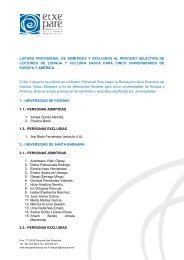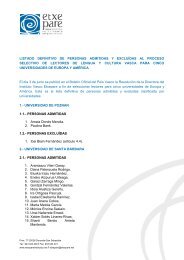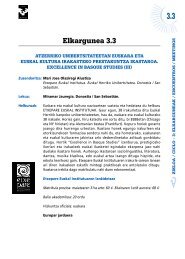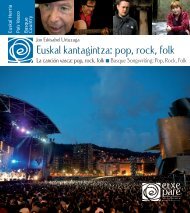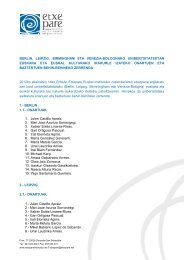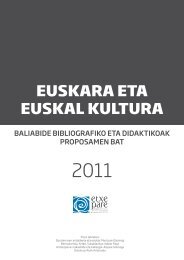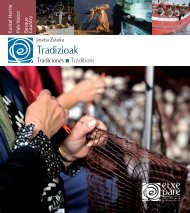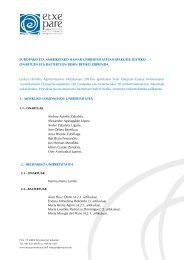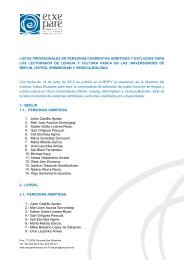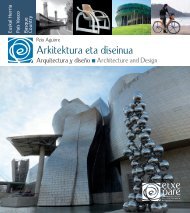XX. mendeko euskal literatura - Etxepare, Euskal Institutua
XX. mendeko euskal literatura - Etxepare, Euskal Institutua
XX. mendeko euskal literatura - Etxepare, Euskal Institutua
Create successful ePaper yourself
Turn your PDF publications into a flip-book with our unique Google optimized e-Paper software.
teoría del género (Edgar Allan Poe, Horacio Quiroga<br />
o Julio Cortazar), sean autores de los siglos XIX y <strong>XX</strong>.<br />
Tras Obabakoak Atxaga publicó varias narraciones en<br />
diferentes antologías (Olaziregi 2010b).<br />
Con la novela juvenil Behi <strong>euskal</strong>dun baten memoriak<br />
(1991) Atxaga se pasó al realismo. El personaje<br />
principal, la vaca Mo que hace suyo la frase “sapere<br />
aude” de Kant, nos explica la dureza de la posguerra<br />
en el País Vasco peninsular. Las siguientes novelas<br />
del autor, Gizona bere bakardadean (1993), Zeru<br />
horiek (1995) y Soinujolearen semea (2003), ofrecen<br />
un acercamiento ético al conflicto político vasco. Las<br />
tres novelas cuentan como protagonista a ex-miembros<br />
de ETA. En el caso de Gizona bere bakardadean<br />
se trata de Carlos, torturado por sus pasadas acciones<br />
armadas; en el caso Zeru horiek nos encontramos<br />
con Irene, condenada a la soledad y a la marginación.<br />
En cuanto a Soinujolearen semea, el eje de la<br />
novela es la recuperación de la memoria histórica, en<br />
concreto el bombardeo de Guernica llevado a cabo<br />
por la Legión Cóndor el 26 de abril de 1937. Para los<br />
ciudadanos vascos Guernica es un lugar de la memoria,<br />
y también se halla presente en otros trabajos de<br />
Atxaga como el ensayo Markak. Gernika 1937 (2007).<br />
En Soinujolearen semea David da cuenta de sus memorias,<br />
ahondando en los dolorosos episodios acontecidos<br />
durante su infancia cuando se encontraba en<br />
Obaba, la Guerra Civil y la posguerra. La Obaba de<br />
la novela no es, a diferencia de la aparecida en Obabakoak,<br />
un lugar en el que ocurren sucesos fantásticos<br />
que escapan a la razón sino una arcadia lejana.<br />
Ahí se encuentra Iruain, localidad natal del protagonista,<br />
rodeada de bucólicos valles verdes, la cual<br />
guarda poca relación con el segundo espacio utópico<br />
de la novela, Stoneham Ranch (Tulare County, California).<br />
La ilusión utópica que en un principio provoca<br />
Stoneham Ranch queda anulada una vez sale a<br />
la luz la relación entre ese lugar y la Guerra Civil. En<br />
verdad, Stoneham Fields (Gran Bretaña) se convirtió<br />
en lugar de exilio para los 4.000 niños vascos que el<br />
contraposition of nature and culture conditions everything<br />
that happens in Obaba. It is a pre-modern<br />
world in which there is no place for concepts like “depression”<br />
or “schizophrenia” and villagers look to<br />
animals to explain things that are beyond their reason.<br />
Obabakoak is, specifically, a collection of interrelated<br />
stories. In all of them the affective landscape<br />
of Obaba is an unlimited virtual space in which the<br />
narrator’s memory weaves the stories. These stories<br />
combine metanarrative reflection with the particular<br />
strategies of fantasy literature. This voyage of fantasy<br />
is, above all else, a literary, inter-textual journey.<br />
Obabakoak pays tribute to the masters of storytelling,<br />
whether those who wrote about the theory of<br />
this genre (E. A. Poe, H. Quiroga or J. Cortazar, for<br />
example), or nineteenth- and twentieth-century authors.<br />
Following Obabakoak, Atxaga published several<br />
short stories in different anthologies (Olaziregi<br />
2010b).<br />
Ataxga moved into realism with the children’s novel<br />
Behi <strong>euskal</strong>dun baten memoriak (1991). The main<br />
character, a cow called Mo who takes as her own<br />
Kant’s saying “sapere aude,” tells us about the harsh<br />
nature of the post-Civil war era in the peninsular<br />
Basque Country. The novels Gizona bere bakardadean<br />
(1993; The Lone Man, 1996), Zeru horiek<br />
(1995; The Lone Woman, 1999) and Soinujolearen<br />
semea (2003; The Accordionist’s Son, 2007) by the<br />
same author offer an ethical analysis of the Basque<br />
political conflict. All three novels have as their main<br />
protagonists ex-members of ETA. In the case of Gizona<br />
bere bakardadean it is Carlos, who is tortured by<br />
his previous violent activities; in the case of Zeru horiek,<br />
we meet Irene, who is condemned to isolation<br />
and marginalisation. As regards Soinujolearen semea,<br />
the focus of the novel is on recovering historical<br />
memory, and specifically the Condor Legion’s bombardment<br />
of Gernika on 26 April, 1937. For Basque<br />
people Gernika is a site of memory, and it also features<br />
in other works by Atxaga, such as the essay<br />
27



